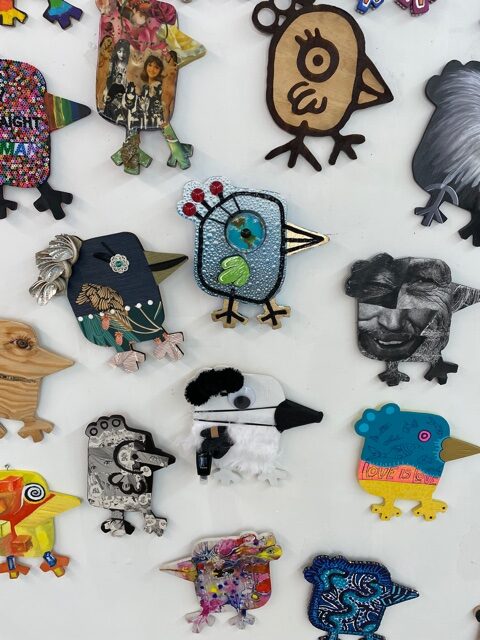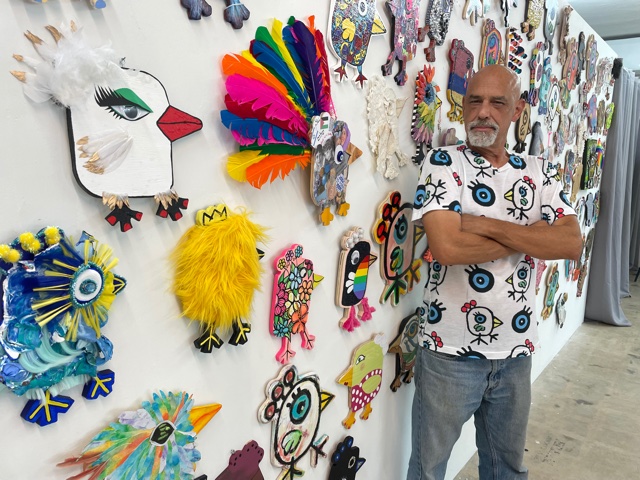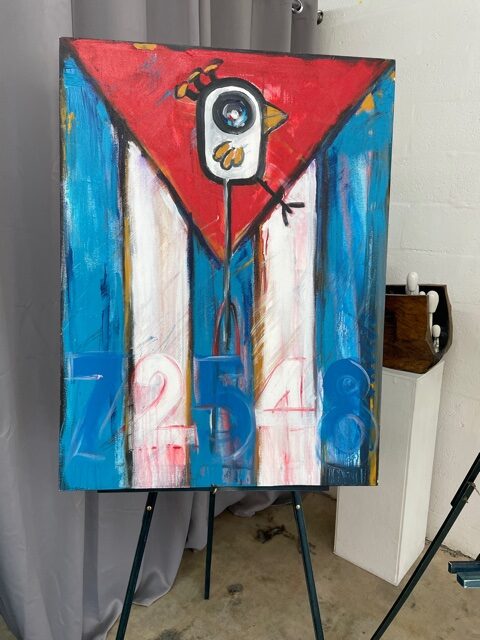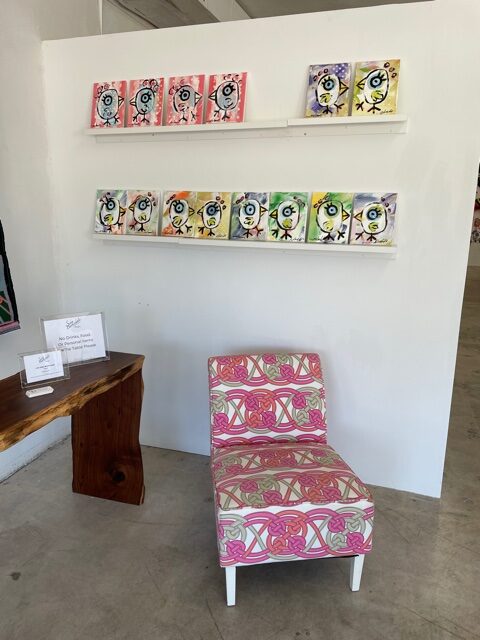The Pajaro Pride Wall Project
An Interview with Rolando Chang Barrero of the Box Gallery
An Interview with Meredith Ockman of the PBC Human Rights Council
By Krista Martinelli for AroundWellington.com

AW: Rolando, what was your inspiration behind the Pajaro Pride Wall Project?
RCB: I try to do something unique every year for Gay Pride. This year I was given the opportunity to work with the Mexican Consulate in Miami, and it was for their first indoor pride exhibition in a Latin American country’s space, at their embassy here in Florida. I wanted to create a whole wall of birds (pajaros). I didn’t want to do it by myself, so I asked my friends from the LGBTQ community to participate. Over 100 different artists from all around the world took part, including Europe, Mexico, but mostly from right here in West Palm Beach. The pajaros will be auctioned off in a silent auction on Saturday night (7/24/21) at 7pm at the Box Gallery in West Palm Beach. Starting bid for each one is $100.
AW: Tell us about the pajaros. What do they mean to you?

RCB: I started making them during the Aids pandemic. The word “Pajaro” started out as derogatory term for a gay person – like “fairy.” Later it was reclaimed and made into a positive word.
Many of my friends became disenfranchised from their families and ended up dying alone. A lot of my friends got cremated. We were left with a memory and a name, and that was it. I made wood cut outs and epitaphs on a bird. I was in my twenties when this was happening in the mid-80s. In my first piece titled “Morbid Morbidity,” you’ll notice that the eyes of the pajaro (bird) are crying blood.

My next piece was titled “Til the Cows Come Home” and it was about all the amendments. After that, my next piece was a political one titled “Jessie Helms in the Garden of Adam & Steve.” It was created on the bedsheets of my ex who died. Actually, all three of these pieces were done on bedsheets, adding an intimacy to the pieces.
You’re heard of Maya Angelou’s “I Know Why the Caged Bird Sings?”
In the gay community, we sing, “Nobody has power over my joy.”
Visit PajaroPride.com for more information on the pajaros and the project.
AW: Tell us about the Silent Auction. Who benefits? What kinds of items will be auctioned off?
RCB: I knew I wanted to support the PBC Human Rights Council because of their amazing work in really looking carefully at how laws adversely affect the LGBTQ+ community and how other laws need to be put in place. The Board Members are all very astute and intelligent people. They respond as things come up, but also have the foresight to comb through laws that exist, laws that have the potential of being detrimental to our gay community. And they correct them to be inclusive, to be fair. A lot of laws in the past weren’t necessarily aimed to deny us, but they didn’t take us into account either. They’ve tackled a lot of work and made the language inclusive of a broader community today.
Then the organization SAVE LGBT came into play – it’s located in Miami. I wanted to raise their name. I asked Rand Hoch, President of the PBC Human Rights Council, who the best recipient in Miami and who the best choice would be, and he didn’t hesitate to mention them.
The Silent Auction will include over 100 pajaros. These were created in collaboration with myself and stylists, designers and others.
AW: What are the details of the event? Date? Time? Place? Timing of auction? Other aspects of the event? Free to attend? Website?
RCB: The preview of the event has already begun. The Pajaro Pride Wall can be seen from 7pm to 9pm, in conjunction with Arts United of Broward County. During the week people can come from 1pm to 4pm to preview the art or by appointment. All of the pajaros are on Instagram and also on PajaroPride.com – all bids all start at $100. The Final (Silent Auction) takes place July 24th from 7pm to 10pm. Then at 10pm the silent auction closes both online and at the Box Gallery. The 12-year-old singer (who won the AW singing contest recently) Carly Cantor will be performing “I Am What I Am,” as well as one other special song. Our guest bartender Avion Goordeen – a young Trinidadian philanthropist and scientist – will be on board, serving up drinks. Goordeen is a huge help in raising funds for the LGBTQ+ community. Our MC will be Ab Fab, otherwise known as Chris Rhoades. There will be a suggested donation at the door of $10, which gets you 2 drink tickets.

AW: How long have you owned the Box Gallery? What makes it unique? What is your next exhibit after this event?
RCB: The Box Gallery is 7 years old. Our next exhibit deals with Crispr and Molecular ethics in the arts, the science of genetic modification. It deals with people who are genetically modified and genetic biotechnology. We will feature 3 artists. We will be inviting ethics speaker Peter Cruise, who will be our guest of honor. Cruise has PhD in Ethics and is the Executive Director of FAU (Lee Collins), Chair of Palm Beach County commission on ethics and on the inspector general committee.
When it comes to our exhibits, if it’s critical, and it’s academic, and quite possibly volatile, I make a point of finding artists or creating art that addresses these issues in a way that people can contemplate them without feeling that they need to make a choice or pass judgement on the pieces (right, wrong, good or bad). The Box Gallery serves as a Think Tank for visual communications.

AW: Tell us about your background as an artist.
RCB: I was the first-born child of exiled parents from Cuba. I grew up aware of a conundrum and was caught in it. On the one hand, we were raised to be grateful and patriotic and thankful to have been given a home in the US. And at the same time, we were aware that while it was a gift, it was a result of very complex policy. A policy that this country reneged on, forced us to leave the dead on the beach in the Day of Pigs and run here for safety. So, it’s always been a very challenging and tumultuous relationship emotionally. I am mostly a child of the 60’s amidst our reality and the reality of this country’s race, where there were riots between black and white. And, as a Cuban American, I felt different, knowing we had no place in these conversations. Yet, even as 3rd class citizens, we could never be less than grateful. We were given the gift of safety.
To this day, I will fight for this country tooth and nail, understanding all the complexities that come along with it. I am the first-born American patriot of this country. I wanted to be a Navy Seal when I was a kid. I grew up very pro-USA. In general, first generation of children of exile tend to be hyper-patriotic, most likely because of the safety net that was thrown at our families at a pivotal point in our lives.
As an artist, I didn’t know I could write as a kid, so I relied on visual language. English was a 2nd language to me, and I never thought I would master it. I fully relied on visual communications. By the time I got to college, I was writing for the Windy City Times in Chicago and had mastered visual communications and understood the press, because I wrote for the press. I bring to the table an understanding in the arts; you could write the most beautiful poem, create the most beautiful image, but unless it gets ink, it never happened. I have been able to master both. My talent is to create work that makes a difference, exhibit work by others that makes a difference and get it in print, so it matters.

Every sale is as cathartic as a death- the experience was beautiful while it was yours, the making, the creating, the relationship you have with the piece. You bare your soul. You are vulnerable. You’re 100% vested. And then it dies. And it’s in someone else’s hands. And then you get to sit around at the funeral parlor and listen to everybody’s version with your loved one. Interestingly enough, you find out more about them than the person you loved.
Although I’m aware of making many mistakes in my life, I am currently considering running for public office. I would need someone to carry on my work as an activist if I were to take that step though.
AW: On the date of the Pajaro Pride Wall Project (July 24th), 12-year-old Carly Cantor will be singing “I Am What I Am” by Shirley Bassey. Why did you choose this song? What does it mean to you?
See the video below.
AW: Rolando, how are you politically active? In what ways are you making a difference?
RCB: I am the person who notices where a “t” needs to be crossed and an “I” needs to be dotted. I am a political underwriter. I make sure the messaging is correct and has the correct social justice grammar. I’m always aiming for the biggest impact and the biggest benefit. I abhor focus groups and separatist groups. Every one that succeeds in this makes it that much more difficult for others to have to cross over. I try to assure that the voice of the intersectional community is considered if not amplified. I serve as President the Palm Beach County Democratic Hispanic Caucus. I’m a delegate also for the Democratic party in my district. I’m also the district representative of the FL LGBTQ+ Democratic caucus. I was appointed District 5 SWA’s Small Business Advisory Committee (SBAC). I was invited as Juror of The Congressional Art Competition for Florida’s District 21. I was elected as VP of the West Palm Beach Democratic Club. I was honored with an invitation to the 46th Presidential Inauguration.
Aside from all of that, I’m just a human being representing other human beings.
AW: Anything else you’d like to add about the event?
RCB: For less than the price of a few cocktails, you can make a difference by supporting the PBC Human Rights Council and walk away with a fabulous work of art… by artists who make a difference in this world.

An Interview with Meredith Ockman of the PBC Human Rights Council
AW: Meredith, tell us about the Palm Beach County Human Rights Council. How did you get involved?
MO: The PBCHRC was founded by Rand Hoch in 1988 and has achieved getting over 160 laws changed to support LGBT people in our communities. When I came out of the closet in 1997, I got kicked out of my family. I didn’t want others to have the same experience, so I put my love and effort into helping the community.
In 2003, I was working for Compass when we partnered with PBCHRC to change the Palm Beach County School Board policy to support students against harassment based on actual or perceived sexual orientation.

AW: Why are LGBTQIA issues important to you? How does this event support that community?
MO: I believe we should have freedoms to love the people we love and do the things that make us happy, as long as it doesn’t hurt anyone else. I believe that people should have the freedom to express themselves and celebrate their individuality. I believe our families and friends should be protected, legally and emotionally as much as possible.
Rolando is taking this opportunity to change hearts and minds through public and financial support for the work and efforts of PBCHRC.
AW: How long have you known Rolando?
MO: I’ve known Rolando for about 4 or 5 years. We have worked on different parts of the same organizations. He’s a good person with a huge heart and a dedication to the community that I love.
AW: Meredith, what other organizations have you been involved in and what role have you played?
MO: I served on the board of National Organization for Women for 10 years, was a member of Palm Beach County Commission on Women Advisory Board and the other organizations can be found on my “About” section of the PBCHRC website: http://www.pbchrc.org/about-us
AW: How old is PBCHRC and what is its main mission? What kinds of projects do they do?
MO: PBCHRC was founded in 1988 by Rand Hoch (the current President).
Their list of accomplishments is amazing. Just visit their website for all of the information: Palm Beach County Human Rights Council (pbchrc.org)

AW: Meredith, anything you’d like to add?
PBCHRC is an all-volunteer organization and depends on the support of the community to continue having the impact to change the community for the better. I would like to thank Rolando for his continued friendship and support.
***
Shop Limited Edition artwork by Rolando Chang Barrero.
https://the-box-gallery.myshopify.com/
***
If you go:
The Pajaro Pride Wall Project
Saturday, July 24, 2021
7pm to 10pm
Silent auction ends at 10pm
The Box Gallery
811 Belvedere Rd.
West Palm Beach, FL 33405
Suggestion donation: $10 (includes 2 drink tickets)
(786) 521-1199 for more information

Writer Krista Martinelli is also the Founder/Editor of AroundWellington.com, the online magazine, bringing you “good news” and “a journalistic breath of fresh air.” She is an active mother of two teenagers and enjoys visiting the Box Gallery and hanging out at Village Music to see live music on the weekends. See AroundWellington.com’s “Mission Statement.” And best of all, “Subscribe” so that you can receive a weekly newsletter with stories like this one.

